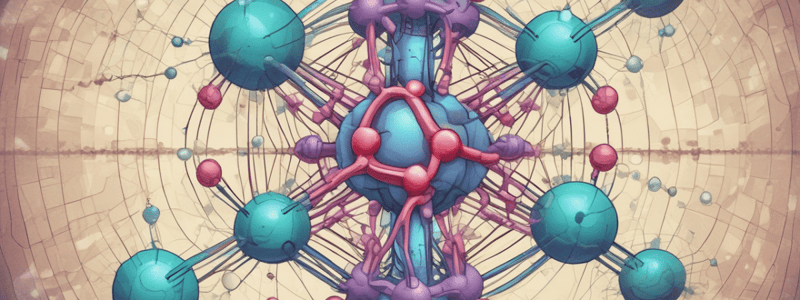Podcast
Questions and Answers
What is the characteristic of the 18e d6 octahedral dihydride in Eq. 6.6?
What is the characteristic of the 18e d6 octahedral dihydride in Eq. 6.6?
- Has mutually cis hydrides (correct)
- Has a square planar structure
- Has mutually trans hydrides
- Has a tetrahedral structure
What is the role of the CO ligand in the OA of H2 to Vaska’s complex?
What is the role of the CO ligand in the OA of H2 to Vaska’s complex?
- It is a strong π donor
- It is a weak π donor
- It is a powerful π acceptor (correct)
- It is a strong σ donor
What happens to the trans-Cl–Ir–(CO) set of ligands in the OA of H2 to Vaska’s complex?
What happens to the trans-Cl–Ir–(CO) set of ligands in the OA of H2 to Vaska’s complex?
- It remains unchanged
- It is replaced by a new ligand
- It becomes mutually cis (correct)
- It becomes mutually trans
What is the reason for the distortion of a d8 ML4 complex towards TBP?
What is the reason for the distortion of a d8 ML4 complex towards TBP?
What is the process that occurs in the initial CO loss from [Ir(CO)3L2]+?
What is the process that occurs in the initial CO loss from [Ir(CO)3L2]+?
What is the effect of bending on the π donor power of the metal?
What is the effect of bending on the π donor power of the metal?
What is required prior to obtaining the 1-coordinate intermediate, Pd(PAr3)?
What is required prior to obtaining the 1-coordinate intermediate, Pd(PAr3)?
What type of compounds do not require prior dissociation of L and can give OA with L2Pd(0)?
What type of compounds do not require prior dissociation of L and can give OA with L2Pd(0)?
What is the order of the SN2 pathway reactions?
What is the order of the SN2 pathway reactions?
What is the typical range of entropies of activation (ΔS‡) for SN2 reactions?
What is the typical range of entropies of activation (ΔS‡) for SN2 reactions?
What is the consequence of the polar transition state in SN2 reactions?
What is the consequence of the polar transition state in SN2 reactions?
What has been found in suitably substituted halides in SN2 reactions?
What has been found in suitably substituted halides in SN2 reactions?
What is the primary consequence of chain termination steps on the reaction?
What is the primary consequence of chain termination steps on the reaction?
Which of the following complexes would be more likely to react with MeI?
Which of the following complexes would be more likely to react with MeI?
What is the rate of ring opening of cyclopropylmethyl radicals?
What is the rate of ring opening of cyclopropylmethyl radicals?
What is the most likely mechanism operating in the reaction of complex A with MeOSO2Me?
What is the most likely mechanism operating in the reaction of complex A with MeOSO2Me?
What is the assumption made regarding the β carbon in the analysis of OA?
What is the assumption made regarding the β carbon in the analysis of OA?
What is the product of a radical recombination that gives a very unusual distribution of α and β spins in CIDNP?
What is the product of a radical recombination that gives a very unusual distribution of α and β spins in CIDNP?
What is the significance of the favored conformation in 1H NMR spectroscopy analysis?
What is the significance of the favored conformation in 1H NMR spectroscopy analysis?
What is the reason why complex B reacts with i-PrI but not with MeOSO2Me?
What is the reason why complex B reacts with i-PrI but not with MeOSO2Me?
What is the net result of the rate-determining step in binuclear oxidative additions involving radicals?
What is the net result of the rate-determining step in binuclear oxidative additions involving radicals?
What further test could be applied to confirm the mechanism of the reaction of complex A with MeOSO2Me?
What further test could be applied to confirm the mechanism of the reaction of complex A with MeOSO2Me?
What is the predicted outcome of inversion at the α carbon, according to the Karplus relationship?
What is the predicted outcome of inversion at the α carbon, according to the Karplus relationship?
What is the primary function of radical clocks in the context of OA?
What is the primary function of radical clocks in the context of OA?
Which of the following complexes would be more likely to undergo reductive elimination with MeOSO2Me?
Which of the following complexes would be more likely to undergo reductive elimination with MeOSO2Me?
What is the favored reaction path for 18e complexes with basic ligands and low-OS metals?
What is the favored reaction path for 18e complexes with basic ligands and low-OS metals?
What is the most likely effect of the presence of MeOSO2Me on the coordination geometry of complex A?
What is the most likely effect of the presence of MeOSO2Me on the coordination geometry of complex A?
What is the minimum lifetime required for the hexenyl radical intermediate to undergo cyclization?
What is the minimum lifetime required for the hexenyl radical intermediate to undergo cyclization?
What is the role of the odd-electron d7 Co(II) in binuclear oxidative additions involving radicals?
What is the role of the odd-electron d7 Co(II) in binuclear oxidative additions involving radicals?
What is the characteristic of the metal complex that favors the reaction path of X- attack followed by protonation?
What is the characteristic of the metal complex that favors the reaction path of X- attack followed by protonation?
Flashcards are hidden until you start studying
Study Notes
Oxidative Addition (OA)
- Prior loss of PAr3 is required to give the very reactive 1-coordinate intermediate, Pd(PAr3), that goes on to give [(PAr3)(Ar′)Pd(μ-Br)]2 as final product.
- More reactive ArI compounds do not need prior dissociation of L and can give OA with L2Pd(0).
SN2 Pathways
- SN2 mechanism is often found in the addition of methyl, allyl, acyl, and benzyl halides.
- The metal electron pair of LnMN (N = oxidation state) directly attacks the R–X σ* at carbon, the least electronegative atom, to give [LnM(N+2)(A)(B)].
- SN2 mechanism is a second-order reaction, accelerated in polar solvents that stabilize the polar transition state, and shows negative entropies of activation (ΔS‡ = −40 to −50 eu).
Radical Mechanisms
- Binuclear oxidative additions often go via radicals, involving 1e rather than 2e OS changes at the metals.
- The rate-determining step is net abstraction of a halogen atom from RX by the odd-electron d7 Co(II) forms R· that subsequently combines with a second Co(II).
Ionic Mechanisms
- In a polar solvent, where HX (X = Cl, Br, I) can dissociate, X− and H+ often give a two-step OA with LnM.
- The metal usually protonates first, followed by X- binding to give LnM(H)(X); rarer is X− attack, followed by protonation.
Reductive Elimination
- In OA of H2 to Vaska’s complex, the initially trans-Cl–Ir–(CO) set of ligands folds back to become cis both in a proposed transient H2 complex and in the final product.
- A ligand may be lost to give the 2e site needed for OA, as occurs in initial CO loss from [Ir(CO)3L2]+ in the OA of H2 to give [Ir(H)2(CO)2L2]+.
Problems and Tests
- Radical clocks can be used to identify radical intermediates, such as the cyclopentylmethyl metal complex formed from hexenyl bromide OA.
- CIDNP (chemically induced dynamic nuclear polarization) can also be used to detect radicals.
- Inversion at carbon can be detected by NMR methods, such as the Karplus relationship between the HCCH′ dihedral angle and 3J(H, H′) coupling constant.
Studying That Suits You
Use AI to generate personalized quizzes and flashcards to suit your learning preferences.



